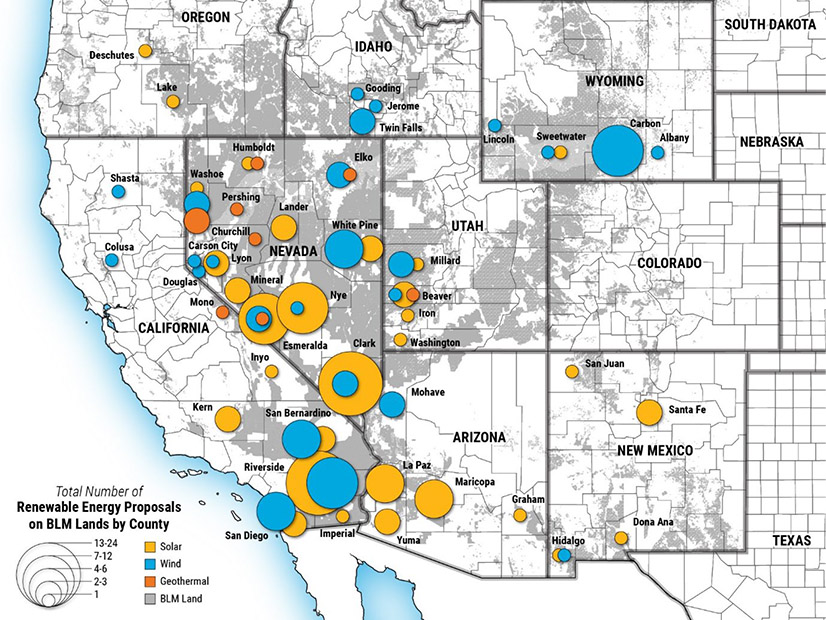
Renewable energy developers looking to build projects on public land may soon see the rent and fees they have to pay drop by more than half, Interior Secretary Deb Haaland announced Tuesday at a clean energy roundtable in Las Vegas.
The dramatic drop in the per-acre rent and per-megawatt fees developers pay is part of a drive by Interior and its Bureau of Land Management to help the Biden administration reach its 2025 goal of putting 25,000 MW of renewable energy projects on public lands, primarily in the West. Haaland also announced that the department will be setting up and staffing special units called Renewable Energy Coordination Offices (RECOs) “to prioritize robust environmental compliance coordination for renewable energy proposals.”
The RECOs will be located in BLM offices across the West, with one each in Arizona, California, Nevada and Utah, according to a DOI announcement.
In a statement included in the announcement, Haaland underlined the “important role” clean energy projects on public land will play in reducing U.S. greenhouse gas emissions and the department’s commitment to “coordination with local, state and elected officials, tribes, and conservation and industry groups.”
BLM Director Tracy Stone-Manning hailed the announcements as “bold steps” that will allow the agency “to attract renewable energy investments on public lands in a way that is environmentally sound.”
While Tuesday’s announcement was light on specifics — such as when the lower rates and RECOs will be rolled out — more detail can be gleaned from a progress report on renewable development on public lands that DOI and BLM submitted to Congress in March.
Authorized to reduce per-acre rental rates for clean energy projects in the Energy Act of 2020, the department implemented initial reductions in California’s Riverside, San Bernardino and San Diego counties in 2021 because of “significant increases in the fair market value for acreage rents” for solar and wind projects in those areas, the report says.
The reduced rates for states, recently published by BLM, range from $8.09/acre in New Mexico to $48.93/acre in Oregon. The reduced rate for all of California is $75.13/acre.
‘Vast Contiguous Areas’
Siting renewable energy on public land remains a potential flash point at the local level. For example, the recently approved Oberon solar project in Riverside County was opposed by some environmental groups, which see it as a threat to sensitive desert ecosystems and animals, such as the desert tortoise and fringe-toed lizard, as reported in The Desert Sun.
But with Biden’s ambitious climate goals and the need to rapidly ramp up solar and wind, “vast contiguous areas available for onshore renewable energy are sparse,” the DOI-BLM report argues. “Therefore, public lands … have a unique role to play” in renewable development.
According to the report, in fiscal year 2021, BLM helped develop 2,890 MW of solar, wind and geothermal energy on public land, a 35% increase over 2020.
Going into 2022, the agency had a pipeline of 54 solar, wind and geothermal projects totaling 33,000 MW that it is prioritizing for permitting by 2025, the report says. BLM is targeting approvals for 3,595 MW of solar in 2022, rising to 13,524 MW in 2024.
The pipeline also includes six interconnection transmission lines — or “gen-ties” — connecting renewable projects to the grid, with a total capacity of 1,732 MW. Four major transmission lines are also on the agency’s priority list: Greenlink West and North, both in Nevada; SunZia, in Arizona and New Mexico; and Transcanyon Cross-Tie, connecting Nevada and Utah.
Processing all those projects and staffing the RECOs will require at least 56 new hires, according to the report, and anticipated projects in states such as Idaho, Montana and the Dakotas could result in an additional RECO with a staff of 10.
Permitting has long been a pain point for renewable energy and transmission development, but whether the DOI initiatives will be enough to move projects forward on expedited timelines remains uncertain. While interconnection queues across the country sit with backlogs of hundreds of megawatts of projects, supply chain delays and the Commerce Department solar tariff investigation have put major dampers on solar development.

